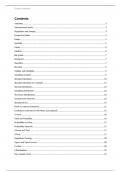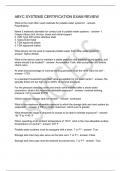Week 1: Introducing Human Resource Management
Chapter 1: Introducing Human Resource Management
Human resource management describes business activities for managing
employee-company relationships.
Individual goals and needs of the three stakeholders:
- Employers aim to create successful, profitable businesses
- Managers aim to achieve business targets through employing the right people in the
right place
- Employees require a fair and safe work environment, in which they can succeed in a
job for which they feel capable of doing and are compensated enough
In order to manage the relationships between stakeholders organisations apply their HRM
strategy, which is composed of:
- Recruitment and selection of employees
- Terms and conditions employees work under
- Equal treatment within an organisation
- Treatment of rule-breaking employees
- Payment and rewarding policies for employees
- Learning and development opportunities provided by an organisation
HR philosophy different businesses also operate in different contexts and have a variation
of views on all kinds of policies.
History of HRM
Industrial Welfare
HRM originated following the industrial revolution.
Welfare officer dealt with employee issues, e.g. compliance, health and safety legislation
etc
Scientific Management
Fredrick Taylor’s scientific management movement aimed to increase productivity through
greater efficiency in production practices, selection and training practices and incentivized
pay for workers.
Labour managers and employment managers oversaw the centralization and
standardisation of certain employment-related functions (e.g. hiring, payroll, record keeping,
and dealing with issues such as absences, recruitment and queries over bonuses etc).
The tight control, resulting from the scientific approach resulted in collective action and trade
unions, which resulted in the HR role to concentrate on industrial relations.
1
, - Trade unions are organised groups of workers which represent members’ interests
in maintaining or improving the conditions of their employment by acting collectively
as a way to challenge employer power.
- Industrial relations is the relationship between employers and employees, with a
focus on those areas of the employment relationship where employers deal with
employee representatives, rather than individuals.
Behavioural Science
Hawthorne Effect led to an emphasis on personal development, a better understanding of
group work, and the importance of working conditions as a means of motivating employees.
-> behavioural science movement
Personnel officer, Personnel management (PM) -> rights for employees around
dismissals, equal pay, pension rights and health and safety
HRM Today
more focused on relationships with the individual rather than the trade union and thus, led to
the current definition of HRM: the strategic and integrated approach taken by an organisation
to the management of its most valued assets, namely its people.
This shift in HRM resulted from a decline in traditional manufacturing industries and
significant growth in the service sector and the emergence of the knowledge worker, which
brought about a decline in trade union membership and the perceived significance of trade
unions.
Shifting demographics, 24/7 society and changing workforce values led to employers and
employees seeking more individualised approaches to HRM.
Personnel management (PM) was associated with control and cost effective operations of
employees. HRM is more focused on the employee as an asset. According to Barney’s
VRIO model, employees are its single most important strategic differentiator. They are
Valuable, Rare, Inimitable and Organized.
Strategic human resource management: where HR is coordinated and consistent with the
overall business objectives, goals and strategy in order to increase business performance.
SHRM takes a macro-level approach, HRM takes micro-level approach.
Factors of distinctiveness:
- size and structure of organization
- sector of operation
- organizational lifecycle
- financial health
- values and ideology
- organizational culture
- workforce characteristics
- established custom and practice
2
,External context comprises many different factors including:
- competition
- technology
- labour market
- legislation and regulation
- ethics
Four critical features (John Storey, 1989):
1. explicitly linked with corporate strategy
2. focuses on commitment rather than compliance of employees
3. employee commitment is obtained through an integrated approach to HR policies in
the areas of rewards, selection, training and appraisal
4. HRM is not the domain of HR specialist, but owned by line managers as a means of
fostering integration
Lifecycle of the employee:
3
, Characteristics associated with HRM:
- strategic approach to the management of people:
the link between HRM strategy and business strategy.
- unitarist frame of reference:
unitarist perspective views the employment relationship as one where both
managers and employees have a common purpose and the organization is
integrated and harmonious
- soft HRM approach
hard approach is where employees are a resource and should be managed
as such, soft approach involves treating people as valued assets
- HR policies and practices are integrated and consistent with the organizational
culture
vertical integration refers to the matching of HRM policies and practices with
business strategy and is also referred to as ‘external alignment’
horizontal integration involves strong consistency and interconnection
between HRM policies and practices internally in order to achieve efficient
performance
- Line managers work in partnership with HR
- evidence based approach
HR does not exist to serve the employee, but to enable a successful and sustainable
business for its owners. The more closely HR is aligned to the employer’s business strategy,
the more successful the outcome of the HR strategy.
Different ways HR strategy can be linked to business strategy:
- separation model where there is no connection
- fit model where the organizational strategy precedes and influences the HR strategy
- dialogue model where the HR strategy has an opportunity to influence the business
strategy as it is being developed
- holistic model where they are developed in tandem
- HR-driven model where the HR strategy and therefore the human resources across
the business drives the development of the business strategy from the bottom up
HR practioners have an impact across four different dimensions:
1. Individual level building effective relationships and good reputations across the
business
2. Organizational level as they are responsible for the design and delivery of
appropriate HR practices that reach right across the organisation
3. Contextual level as their understanding of the internal and external environments
specific to their organisation, are vital in developing the appropriate HR strategy
4. Strategic level as they have a role in developing leader, manager, and employee
perceptions of the HR function as adding value and enabling them to deliver on the
business strategy, rather than just managing the more basic operations of the
employment relationship
The following competencies needed in the mix of the HRM function were identified:
1. Credible activists deliver on their promises, are trusted by the business and take
action positively as needed by the business
4






